 Running places significant demands on the lower body—from muscles propelling you forward to joints absorbing impact. To maintain performance and prevent injuries, a structured mobility routine is essential. Below are key pre-run activation exercises and post-run stretches to keep you moving efficiently.
Running places significant demands on the lower body—from muscles propelling you forward to joints absorbing impact. To maintain performance and prevent injuries, a structured mobility routine is essential. Below are key pre-run activation exercises and post-run stretches to keep you moving efficiently.
Pre-Run Routine
A proper warm-up prepares your body for movement and helps prevent imbalances. Since running primarily involves forward motion, incorporating side-to-side and rotational movements improves mobility and stability.
Pendulum Leg Swings
This dynamic exercise loosens up the hips and knees while enhancing mobility.
How to do it:
- Stand tall and hold onto a sturdy surface (e.g., a chair or dowel rod) for support.
- Shift your weight onto one leg, lifting the opposite foot slightly off the ground.
- Swing the elevated leg side to side in a controlled motion.
- Perform 10-12 reps per leg for 3 sets.
Cossack Squats
Engaging muscles not typically used in straight-line running, this lateral squat improves hip mobility and balance.
How to do it:
- Stand with your feet wider than shoulder-width apart.
- Shift your weight to one side, bending the knee and keeping the other leg extended.
- Keep your torso upright and core engaged as you lower.
- Return to standing and switch sides.
- Perform 10 reps per side for 2 sets.
Post-Run Routine
After running, focus on static stretches to release tension and promote recovery.
Forward Fold IT Band Stretch
The IT band often tightens due to repetitive motion, leading to discomfort.
How to do it:
- Stand with one leg crossed over the other.
- Slowly fold forward, reaching toward the ground while maintaining balance.
- Hold for 15-20 seconds, then switch sides.
- Repeat 2-3 times per side.
Seated Hamstring Stretch
Running shortens the hamstrings, leading to tightness. This stretch helps restore flexibility.
How to do it:
- Sit on the ground with one leg extended at a slight angle (about 45 degrees).
- Bend the other leg, placing the foot near your inner thigh.
- Gently reach toward the extended leg, keeping your back straight.
- Hold for 15-20 seconds, then switch sides.
- Repeat 2-3 times per leg.
Incorporating these mobility exercises into your routine prepares your body for movement and aids recovery post-run. Prioritizing mobility reduces injury risk, improves efficiency, and keeps you running strong. Aim to complete this routine before and after every run for the best results!
Enhance flexibility and mobility with a personalized full-body stretch designed to target major muscle groups and specific areas of discomfort. These sessions can help improve range of motion, support injury recovery, and go beyond what self-stretching can achieve. Check out Individual Stretching with NIFS Health Fitness Specialist, Shelby Graves (sgraves@nifs.org) today!

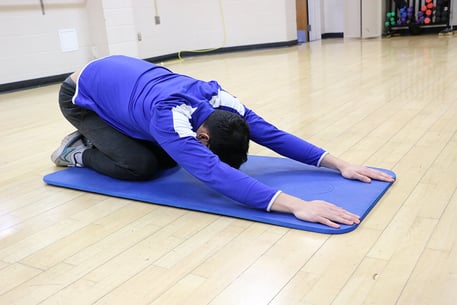
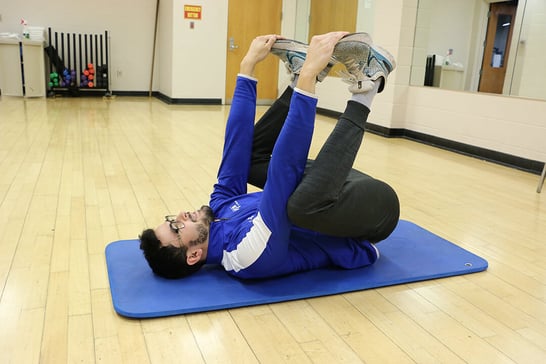
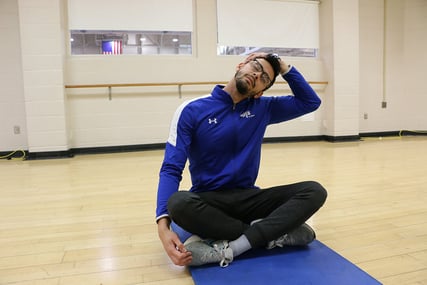
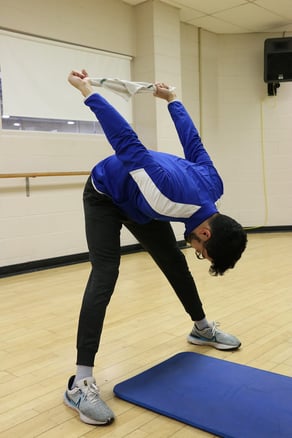
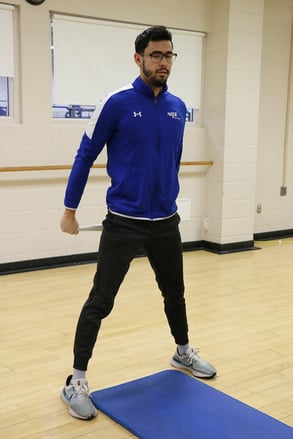
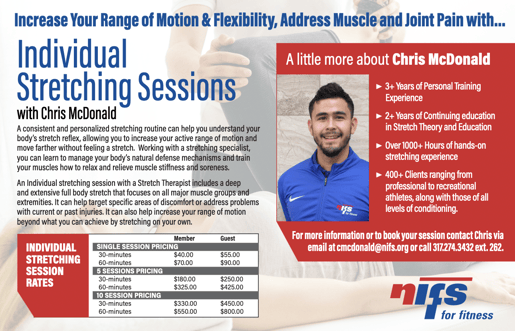
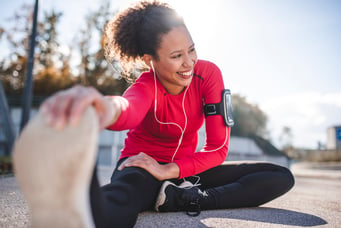 Chances are if you are like me, you have been told your whole life, “Make sure you’re stretching, it’s important!” But to many, the first thought that pops into their head when they think about stretching is, “Why?” And that is a very understandable response because stretching can involve a lot of discomfort (in the beginning) and to some, it might even cause a bit of pain. But there certainly is a method to the madness, and a reason why stretching is a vital component of your fitness program and, ultimately, your lifestyle.
Chances are if you are like me, you have been told your whole life, “Make sure you’re stretching, it’s important!” But to many, the first thought that pops into their head when they think about stretching is, “Why?” And that is a very understandable response because stretching can involve a lot of discomfort (in the beginning) and to some, it might even cause a bit of pain. But there certainly is a method to the madness, and a reason why stretching is a vital component of your fitness program and, ultimately, your lifestyle. 
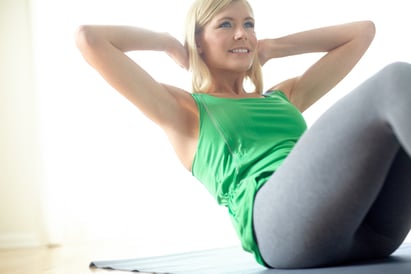 Low-back pain is an issue with so many people who are spending entire days sitting to do work. Stretching and mobility work will help ease the lower-back pain, getting the muscles to relax and loosen. Here are some moves to get loose and then start to strengthen the core to keep the pain away.
Low-back pain is an issue with so many people who are spending entire days sitting to do work. Stretching and mobility work will help ease the lower-back pain, getting the muscles to relax and loosen. Here are some moves to get loose and then start to strengthen the core to keep the pain away.
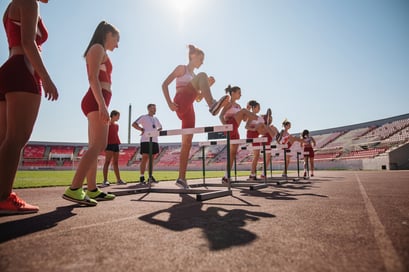 I wish I had a dollar for every time a coach has said to me, “That athlete has stiff hips,” or “That athlete folds over at the waist,” etc. So how do I help an inefficient athlete with stiff hips? I use simple hurdle stretches that train my athletes to bend.
I wish I had a dollar for every time a coach has said to me, “That athlete has stiff hips,” or “That athlete folds over at the waist,” etc. So how do I help an inefficient athlete with stiff hips? I use simple hurdle stretches that train my athletes to bend.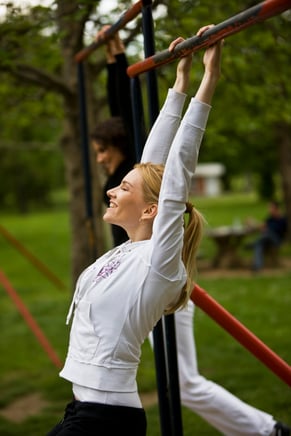 How many times have you looked around a room full of people and seen nearly everyone buried in their phones? Their shoulders are slumped forward and their head is hung low. Or maybe you’re at work, and everyone’s busy composing emails with that same forward head position? Chances are, it won’t be long before you notice this posture elsewhere, and it can wreak havoc when it comes to the health of your shoulders.
How many times have you looked around a room full of people and seen nearly everyone buried in their phones? Their shoulders are slumped forward and their head is hung low. Or maybe you’re at work, and everyone’s busy composing emails with that same forward head position? Chances are, it won’t be long before you notice this posture elsewhere, and it can wreak havoc when it comes to the health of your shoulders. How many times have you had every intention of heading to the gym either before or after work, only to be deterred by nagging back pain? Maybe you woke up feeling stiff and sore, or maybe you had a long day at work and had a flare-up of pain. Either way, you’re far less motivated to be active when in pain, which quickly turns into a slippery slope. Pain is often a signal that something is not right, and your body will likely encourage behaviors that relieve your pain or prevent it from worsening. If your pain increases with movement, the likelihood of you working out becomes very low. The less you move, the better you feel, and voila, your back pain “magically” goes away!
How many times have you had every intention of heading to the gym either before or after work, only to be deterred by nagging back pain? Maybe you woke up feeling stiff and sore, or maybe you had a long day at work and had a flare-up of pain. Either way, you’re far less motivated to be active when in pain, which quickly turns into a slippery slope. Pain is often a signal that something is not right, and your body will likely encourage behaviors that relieve your pain or prevent it from worsening. If your pain increases with movement, the likelihood of you working out becomes very low. The less you move, the better you feel, and voila, your back pain “magically” goes away!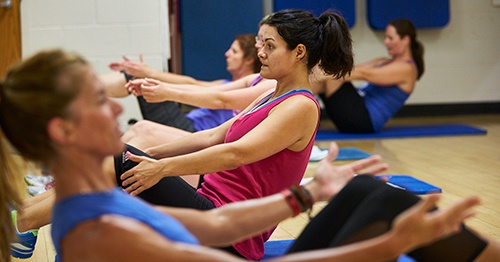 When it comes to working out, I have always been the “faster, harder, stronger, better” type. If I’m not going to sweat and feel like I’ve accomplished something, what’s the use? As such, I never put much stock in mind/body classes. What could that type of exercise possibly offer that I wasn’t getting through my intense cardio and/or strength training sessions?
When it comes to working out, I have always been the “faster, harder, stronger, better” type. If I’m not going to sweat and feel like I’ve accomplished something, what’s the use? As such, I never put much stock in mind/body classes. What could that type of exercise possibly offer that I wasn’t getting through my intense cardio and/or strength training sessions? 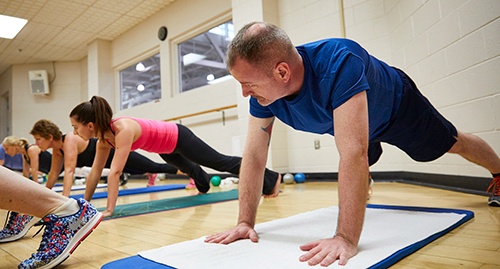 So the ultimate question is, what specifically can you expect when you walk into the NIFS Group Fitness Studio shortly before 5pm on Wednesdays? You can expect a low-impact entire-body workout that flows nonstop for 50 minutes to upbeat, current, familiar music. You can expect careful instruction on form. You can expect an occasional self-assessment on strength and flexibility. And, even though this is not a cardio class, you can expect to sweat! Mats will always be used, and often you will be instructed to grab a small piece of equipment (small weighted balls, light dumbbells, springloaded rings, small towels, and exercise bands are commonly used). Shoes are optional. Let the instructor know if you have any injuries.
So the ultimate question is, what specifically can you expect when you walk into the NIFS Group Fitness Studio shortly before 5pm on Wednesdays? You can expect a low-impact entire-body workout that flows nonstop for 50 minutes to upbeat, current, familiar music. You can expect careful instruction on form. You can expect an occasional self-assessment on strength and flexibility. And, even though this is not a cardio class, you can expect to sweat! Mats will always be used, and often you will be instructed to grab a small piece of equipment (small weighted balls, light dumbbells, springloaded rings, small towels, and exercise bands are commonly used). Shoes are optional. Let the instructor know if you have any injuries. 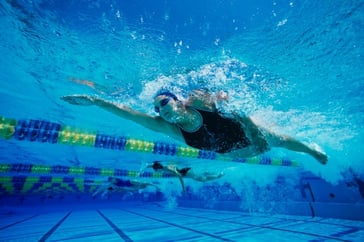 Nothing sounds more dreadful to me than putting on my suit to jump into the pool to do some lap swimming on a sub-20-degree winter day (unless, of course, it’s a belly-smacker challenge—then I’m in!). But with the vast benefits that come from swimming, the draw tends to be a little bit enticing (and here are some ideas for
Nothing sounds more dreadful to me than putting on my suit to jump into the pool to do some lap swimming on a sub-20-degree winter day (unless, of course, it’s a belly-smacker challenge—then I’m in!). But with the vast benefits that come from swimming, the draw tends to be a little bit enticing (and here are some ideas for 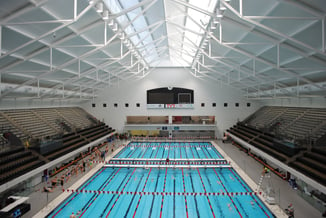
 In part 1
In part 1